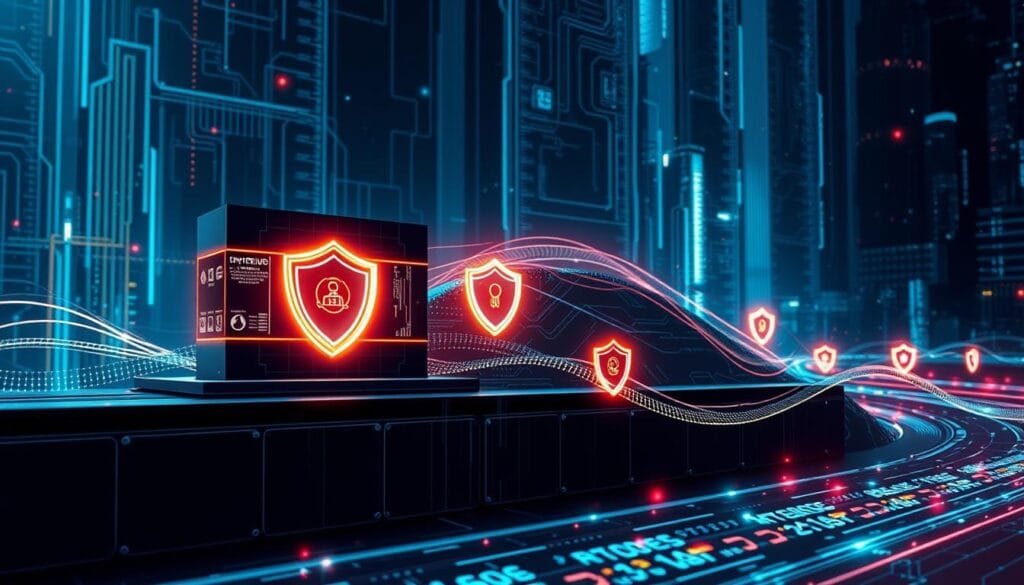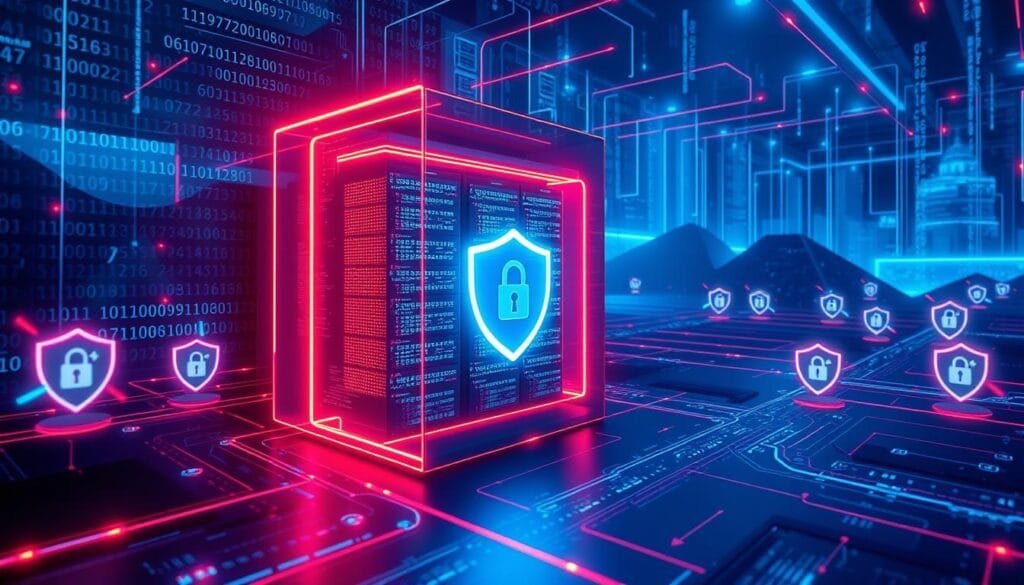In today’s digital world, firewalls, antivirus software, and encryption are key to keeping our online world safe. They protect our devices, networks, and important data from many threats. Let’s dive into why these tools are so important and how they can help keep your digital life secure.
Key Takeaways
- Firewalls act as a gatekeeper, monitoring and controlling the flow of network traffic to prevent unauthorized access.
- Antivirus software is a critical defense against malware, detecting and removing threats to protect your devices.
- Encryption ensures that your data remains secure, even if it falls into the wrong hands, by scrambling the information.
- Integrating these security solutions is crucial for building a comprehensive cybersecurity strategy.
- Staying informed about emerging threats and best practices is essential for maintaining robust protection.
What is a Firewall?
A firewall is key to network security. It acts as a shield, checking and controlling network traffic. It does this by following set security rules. This way, a firewall keeps your devices and network safe from unauthorized access and cyber threats like intrusion prevention.
Understanding Network Security
In today’s digital world, cyber threats are getting more complex. That’s why network security is so important. Firewalls are vital in protecting your network. They use access control and packet filtering to make sure only allowed traffic gets through.
Types of Firewalls
There are different types of firewalls, each for specific security needs:
- Packet Filtering Firewalls – These firewalls look at packet headers to decide if traffic is allowed or blocked.
- Stateful Inspection Firewalls – These firewalls keep track of network connections to stop unauthorized access.
- Unified Threat Management (UTM) Firewalls – These advanced firewalls offer intrusion prevention, anti-virus, and content filtering for full network protection.
| Firewall Type | Key Features | Advantages |
|---|---|---|
| Packet Filtering | Examines packet headers for access control | Lightweight, fast processing |
| Stateful Inspection | Tracks connection state for enhanced security | Provides deeper analysis, better protection |
| Unified Threat Management (UTM) | Combines multiple security features | Comprehensive protection in a single solution |
The Importance of Firewalls
Firewalls are key to keeping your network and devices safe from threats. They act as a first defense, stopping bad traffic, and watching network activity to find and stop breaches. Having a strong firewall is crucial for protecting your online stuff and keeping your data safe and available.
A firewall controls who can get into your network. It sits between your network and the internet, checking all traffic to make sure it meets your security rules. This stops unauthorized access, intrusion prevention, and keeps your important info safe from others.
Firewalls are also important for network security by watching network traffic. They spot and warn you about strange activities, like hacking tries or odd data moves. This lets you act fast to stop threats. It helps keep your systems and data safe.
Also, a good firewall helps with secure remote access. It lets authorized people safely connect to your network. With strong access rules, only those who should can get to your resources. This makes your digital space more secure.
“A firewall is like a gatekeeper, standing guard to protect your network from unauthorized access and potential threats.”
In our connected world, where cyber threats keep changing, a good firewall is very important. It helps reduce the risk of data breaches and unauthorized access. This keeps your business’s important stuff safe and ensures you can keep running smoothly.
Antivirus Software: A Vital Line of Defense
Antivirus software is key in protecting our digital world from threats. It helps find, stop, and remove malware like viruses and spyware. This keeps our devices safe and our data secure.
How Antivirus Software Works
Antivirus software uses a strong defense system. It checks files and programs against a big list of known malware. This helps it quickly spot and block threats it has seen before.
But, antivirus software has grown to do more. It now watches how programs act to find new threats. This way, it can catch malware that’s new or unknown, giving you extra protection.
Choosing the Right Antivirus Solution
There are many antivirus options out there. It’s important to pick one that meets your needs. Look at things like how well it protects against malware, how it finds threats, and how it affects your computer’s speed. Also, make sure it updates automatically and has good security features.
Using a strong antivirus can really help keep your devices and data safe. Be proactive with your antivirus choices to stay ahead of cyber threats.
Encryption: Protecting Data Privacy
Keeping your sensitive data safe is more important than ever in our digital world. Data encryption is a key tool that turns your data into a secret code. This keeps it safe from people who shouldn’t see it. By learning about cryptography, you can keep your personal info, money details, and important documents safe.
Data encryption changes your data into a mix of characters that looks like gibberish. It uses complex math to make the data unreadable to others. Only those with the right decryption key can make it readable again. This keeps your data privacy and data security safe.
There are many ways to encrypt data, each with its own benefits. You can use symmetric-key encryption with one key for both making and breaking the code. Or, you can use asymmetric-key encryption with a public key for making the code and a private key for breaking it. Choosing the right encryption method is key to protecting your online stuff.
| Encryption Technique | Description | Key Features |
|---|---|---|
| Symmetric-key Encryption | A single shared key is used for both encryption and decryption. |
|
| Asymmetric-key Encryption | A public key is used for encryption, and a private key is used for decryption. |
|
Using data encryption helps keep your private info safe. It makes sure your data privacy and data security stay strong against new cybersecurity dangers. Learning about cryptography is a big step towards a safer digital life.
Firewall Rules and Configurations
Setting up your firewall right is key to keeping your network safe. As a security expert, I’ll guide you on how to set up firewall rules. This includes port forwarding, access control, and stateful inspection. These steps will help secure your network and keep your devices safe from threats.
Best Practices for Firewall Setup
Creating strong firewall rules is the first step in securing your network. These rules decide how your firewall handles traffic, controlling who can access your systems. By setting these up carefully, you can control who gets into your network.
Port forwarding is another important part of firewall setup. It lets you direct certain traffic to specific devices in your network. This keeps access secure while allowing you to use remote access and host services like web servers.
Stateful inspection is also key for firewalls. It tracks network connections to ensure only expected traffic gets through. This helps catch and stop attacks like port scans and unauthorized access.
| Firewall Configuration Best Practices | Description |
|---|---|
| Establish Comprehensive Firewall Rules | Define clear, granular rules to control incoming and outgoing network traffic. |
| Implement Port Forwarding | Carefully configure port forwarding to enable remote access and host network services securely. |
| Utilize Stateful Inspection | Leverage the power of stateful inspection to monitor and validate network connection states. |
| Regularly Review and Update Configurations | Periodically review and update firewall rules and settings to adapt to evolving security threats. |
By following these best practices for firewall configuration, you can make a strong security system. This will protect your network and keep your devices safe from many threats.
Integrating Security Solutions
Effective cybersecurity means using many security solutions together. By using firewalls, antivirus software, and encryption, businesses can protect against cyber threats. This mix is key to keeping data safe, keeping networks secure, and protecting the whole organization.
Building a Comprehensive Security Strategy
Creating a strong security strategy is more than just picking security tools. It’s about linking these tools together to work better. This method, called unified threat management, makes your network security stronger against many cyber dangers.
- Use firewalls to watch and control who gets into your network, blocking bad traffic and unauthorized access.
- Put in strong antivirus software to find, stop, and remove malware, keeping your systems and data safe.
- Use encryption to protect important info, so if someone tries to grab it, they won’t be able to read it.
- Make sure these security tools work together well, creating a strong security integration for your company.
This full security strategy boosts your network security and helps protect your business from many cyber threats.

“Cybersecurity is not just about implementing individual security measures; it’s about integrating them to create a formidable defense against the ever-evolving threat landscape.”
| Security Solution | Key Benefit | Contribution to Comprehensive Security |
|---|---|---|
| Firewalls | Network traffic monitoring and control | Filters out suspicious activity and unauthorized access attempts |
| Antivirus Software | Malware detection and removal | Protects systems and data from compromise |
| Encryption | Data privacy and confidentiality | Ensures sensitive information remains unreadable to unauthorized parties |
Emerging Threats and Security Challenges
The world of cybersecurity is always changing, with new threats popping up all the time. As a business owner or IT expert, it’s key to keep up with the latest security risks. You need to be proactive to protect your network and data from threats like ransomware and hacking.
Ransomware is a big threat now. These programs encrypt your files and demand payment to unlock them. To fight this, keep your systems updated and train your team on security. This way, you can lessen the damage from these attacks.
Another big challenge is managing vulnerabilities. With more devices connected online, hackers have more ways to get into your system. To stay safe, update your systems often and check for vulnerabilities. This helps you stay one step ahead of threats.
| Emerging Cybersecurity Threat | Impact | Recommended Mitigation Strategies |
|---|---|---|
| Ransomware Attacks | Encryption of files, data loss, and financial impact | Regular backups, employee security awareness training, and robust network security measures |
| IoT Device Vulnerabilities | Unauthorized access to network, data breaches, and system compromise | Proactive vulnerability management, regular system updates, and comprehensive security assessments |
| Advanced Persistent Threats (APTs) | Long-term, sophisticated attacks that evade detection and steal sensitive data | Threat monitoring, incident response planning, and collaboration with cybersecurity experts |
To tackle these threats, a strong security plan is key. It should include both technical tools and training for your team. By staying informed and adapting to new threats, you can protect your business and its important data.
“The only way to ensure the security of our digital world is to make cybersecurity a shared responsibility between businesses, governments, and individuals.”
Securing Remote Access and VPNs
In today’s world, keeping remote access and VPNs secure is key to protecting your network and data. More people work from home or on the move. It’s vital to have strong security to fight off cyber threats and keep out unauthorized users.
Using a reliable VPN is a great way to secure remote access. VPNs make an encrypted tunnel between your device and the company’s network. This keeps sensitive info safe from others. With a VPN, you can keep access security, network security, and access control strong, even when workers are not in the office.
When setting up a VPN, following best practices is important. This means updating the VPN software often, using strong authentication, and controlling who can access. These steps help prevent unauthorized remote access and keep your company’s data and systems safe.
| VPN Features | Importance |
|---|---|
| Encryption | Protects sensitive data from interception |
| Authentication | Verifies user identity to prevent unauthorized access |
| Access Control | Restricts user privileges to specific resources |
| Logging and Monitoring | Enables tracking and analysis of user activities |
With a well-configured VPN, you can make sure your remote workers have safe access to what they need. At the same time, you protect your company’s important data and systems.

“Securing remote access is no longer a nice-to-have, but a necessity in today’s work environment. A robust VPN solution is the foundation of a comprehensive network security strategy.”
Security Awareness and User Education
Cybersecurity isn’t just about tech; it also needs user help. By building a strong cybersecurity awareness culture and giving thorough user education, we can make our employees ready to spot and handle threats. This makes our whole organization more secure.
Social engineering is a big threat where hackers trick people into sharing secrets or doing things that hurt security. To fight this, we teach our users about security best practices. This includes spotting phishing emails, avoiding suspicious links, and keeping passwords strong.
- Set up regular security training to keep employees updated on the latest threats and how to avoid them.
- Use posters, emails, and workshops to remind people why cybersecurity matters.
- Make a work culture where employees are encouraged to report anything strange and work with the IT team to make security better.
By focusing on user education and cybersecurity awareness, we can fight off many security risks, like social engineering attacks and data breaches. This all-around approach is key in today’s fast-changing threat world.
| Best Practices for Security Awareness and User Education | Benefits |
|---|---|
| Regular training and communication | Keeps employees informed and involved in security efforts |
| Gamification and interactive exercises | Makes learning security stuff fun and helps people remember it |
| Promoting a culture of security-conscious behavior | Gets employees to be active in spotting and stopping threats |
| Continuous feedback and improvement | Helps the program grow and tackle new security issues |
With a full security awareness and user education program, we can make our employees the first ones to defend against cyber threats. This helps our whole organization stay strong and safe.
“The weakest link in any security system is the human element. Educating and empowering employees is crucial for effective cybersecurity.”
Regulatory Compliance and Security Audits
We have a big responsibility to protect the sensitive info our clients and customers share with us. We must follow many rules and laws about data protection. It’s key to keep up with regulatory compliance and do security audits often. This helps keep our business safe and avoids big fines or legal trouble.
Our business type might make us follow different rules, like the GDPR in the EU, HIPAA in the US, or PCI DSS for credit card info. These rules tell us how to keep sensitive data safe and secure. They cover things like keeping data private, making sure it’s not changed or lost, and keeping it available when needed.
Security audits are very important for us. They help find weak spots and make sure we meet the rules. In these audits, we check how well our security tools like firewalls and encryption work. Then, we fix things to make our data protection better.
- Keep our security rules and steps up to date with new laws.
- Do risk assessments often to find and fix threats.
- Use strong access controls to keep unauthorized people out of sensitive data.
- Train our staff on how to handle data safely and be aware of security risks.
- Keep detailed records of how we follow the rules to show we’re serious.
“Regulatory compliance is not just a legal requirement, but a moral obligation to protect the trust and privacy of our stakeholders.”
By focusing on regulatory compliance and doing deep security audits, we protect our business and gain trust with our clients and customers. It’s a key step for our business to do well and last a long time.
Conclusion
In my journey through the world of cybersecurity, I’ve learned how important firewalls, antivirus software, and encryption are. They work together to protect our digital world from threats.
Firewalls watch over our networks, keeping out unwanted visitors and attacks. Antivirus software scans for and stops malware that could harm our devices and data. Encryption keeps our private information safe by making it unreadable to others.
Thinking back, I realize that staying safe online means being proactive. Using these tools and keeping them updated helps protect our digital stuff. This way, we can keep the trust of our customers, clients, or partners.
FAQ
What is a firewall and how does it work?
A firewall is a security system that checks and controls network traffic. It does this based on set security rules. It acts as a shield, keeping your devices and network safe from unauthorized access and cyber threats.
What are the different types of firewalls?
There are several types of firewalls, like packet filtering firewalls, stateful inspection firewalls, and unified threat management (UTM) firewalls. Each type offers different security levels and features for specific network security needs.
Why is having a firewall important for network security?
Firewalls are key to protecting your network and devices. They block harmful traffic, stop unauthorized access, and watch network activity to find and stop threats. Using a well-set firewall is vital for keeping your digital assets safe.
How does antivirus software work, and how can I choose the right solution?
Antivirus software finds, stops, and removes malware like viruses and spyware from your devices. It uses signature-based detection and behavior-based analysis. When picking an antivirus, look at compatibility, real-time protection, and updates for the best security.
What is encryption, and how does it protect my data?
Encryption changes your data into a code, keeping it safe and private. It stops unauthorized access to your sensitive info, like financial details and personal messages.
What are some best practices for setting up and configuring a firewall?
Setting up your firewall right is key. Good practices include setting up rules, enabling port forwarding, controlling access, and using stateful inspection. This ensures your network is secure and your devices are safe from threats.
How can I integrate different security solutions to create a comprehensive security strategy?
Combining security solutions like firewalls, antivirus software, and encryption is crucial for strong cybersecurity. This approach helps you build a strong defense against cyber threats.
What are some emerging cybersecurity threats and challenges I should be aware of?
Cybersecurity is always changing, with new threats and challenges coming up. It’s important to know about the latest risks and be proactive. This includes doing security checks, managing vulnerabilities, and training your team on security.
How can I secure remote access and VPNs for my organization?
With more people working remotely, securing your network and data is crucial. Use secure remote access, VPNs, and strong access controls. This helps your employees work safely and securely from anywhere.
How can I foster a culture of security awareness and educate my users?
Cybersecurity needs everyone’s help, not just tech solutions. Creating a security-aware culture and educating your team helps them spot and handle threats. This makes your organization more secure.
What regulatory compliance and security audit requirements do I need to consider?
Your industry and location may have rules and laws for data protection. Regular security audits and following these rules are key. They protect your organization and avoid fines or legal trouble.


